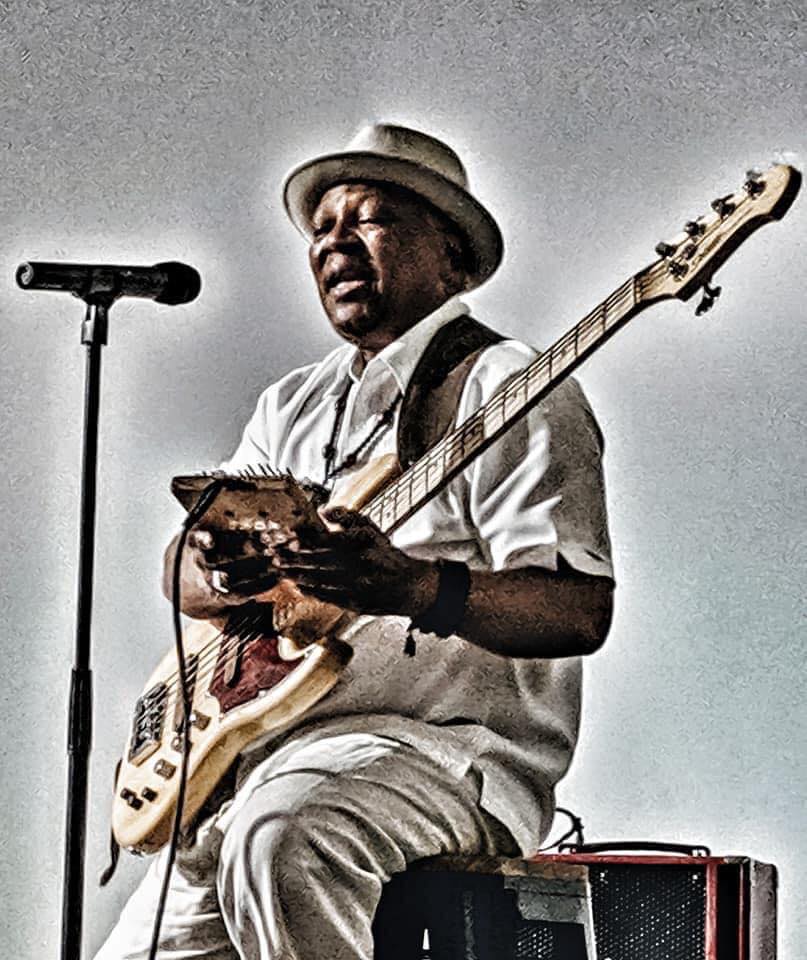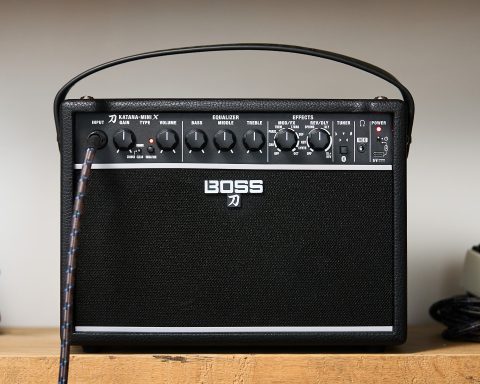Few bassists possess a sound as instantly recognizable as Soweto-born Bakithi Kumalo. A simple mention of his legendary fretless break in Paul Simon’s “You Can Call Me Al” is sure to prompt a roomful of enthusiastic air bass. Yet Kumalo had already cut his teeth across South Africa before receiving the call to play on sessions for Simon’s Graceland. His fluidity, groove, and unbending reverence for the song have made him a revered collaborator with artists from Cyndi Lauper and Herbie Hancock to Grover Washington Jr. and Mickey Hart. Kumalo’s evocative 2021 release, What You Hear Is What You See, chronicles the musician’s journey to the United States. The four-string icon talks about township beginnings, his longstanding role with Simon, and how he encourages the next generation of players.
Soweto Stories
Speaking on Zoom from his New York studio, Kumalo sits in front of memorabilia, reflecting on a lifetime in music. He beams when speaking of his earliest exposure to the instrument that would shape his destiny. “My uncle played saxophone, and his friend had a double bass,” Kumalo recalls. “He showed me G, D, A, and told me, ‘Next week you must remember these things. It is very important.’”
The budding bassist couldn’t get enough, even creating a cardboard version for practicing. Eventually, an opportunity arrived. “My uncle took me to his wedding gig, and the bass player was drunk,” Kumalo recounts. “So, my uncle says, ‘We’ve been teaching you, so what did you learn? Can you play the song?’”

“I’ve never been to school. My school was going to every part of the townships to find music and learn. Growing up in South Africa, each culture has its music.”
They handed him a small bass, and the clouds parted. “As soon as they placed it in my hands, I knew this is what I want to do.” From that moment, Kumalo was on a ride. “I’ve never been to school. My school was going to every part of the townships to find music and learn. Growing up in South Africa—Johannesburg, Soweto, each culture has its music.”
A Singer from Jamaica
By his teens, Kumalo was an in-demand session musician due to his superb feel, open ears, and work ethic. “I was ready, always on time, and respecting the people’s music.” Still, a fortuitous surprise was right around the corner.
“I was working as a mechanic to help my mother, who was sick,” Kumalo says. “My boss says, ‘We got a call. Paul Simon is looking for you. He explains it’s Paul Simon from Jamaica, who sings the reggae song ‘Mother and Child Reunion,’ so I figure he’s a Rasta,” Kumalo laughs. “He says, ‘No, he’s from Jamaica, Queens.’”
A track featuring Kumalo ended up in heavy rotation on Simon’s stereo as he immersed himself in African sounds, including a cappella group Ladysmith Black Mambazo. “Paul fell in love with the grooves. He listened over and over and decided, ‘Let me fly to South Africa and see what’s going on.’”
Kumalo’s sound, all deft syncopation, rubbery slides, and horn-like timbre, impacted the nascent album. “I was playing fretless, and nobody was playing fretless then. It was very difficult, but I stayed with it because I saw something special.” That unique approach grew into a career spanning multiple decades. “I always say Graceland was a godsend,” Kumalo explains, his voice full of quiet appreciation.
After All These Years
After thirty-seven years of playing with Simon, Kumalo has keen insights into working with the iconic singer-songwriter. “It is like being in a classroom with your teacher who knows more than you do. And also, the teacher who pays you,” he adds with a grin. “Paul gave me an opportunity to learn. He never put pressure on me.”
Traveling with a superstar meant plenty of opportunities to soak up experiences, especially for someone as curious as Kumalo. “On the bus, I was always talking to the crew and learning.” Exploring the globe doing what he loved was a marked contrast from the bassist’s humble beginnings. “South Africa was a mess then. I just wanted to play music and have a better life. And I did that and was consistent with it.”
"Paul gave me an opportunity to learn. He never put pressure on me."
A Journey in Song
Like many musicians, Kumalo found himself unexpectedly homebound in 2020 after years of nonstop touring and recording. During that reflective period, Kumalo set out to create a piece of art chronicling his journey from South Africa to the United States. What You Hear Is What You See features contributions from his extensive network of players. “It gave me time to put this together,” Kumalo confirms. “I have a good story to tell, and I told it by helping musicians who didn’t have a job.”
The personal nature of the project extends to the cover art as well. “We sent a note saying we needed somebody to develop a cover design from this title. People sent me paintings, but there was one guy from Portugal; I loved his painting. He was a bass player—I didn’t even know.” Much like Kumalo meeting Simon in the ’80s, a sense of fate was at play. “It was great timing for him and me.”
What You Hear Is What You See flows from start to finish—a sonic trip beginning with the title track which features spoken word by Ugandan vocalist, Tshila. “I knew exactly where I wanted this record to go,” Kumalo explains. “This is not a pop record, but it’s a record that means something to me.”
Over the course of ten songs, the album’s emotional essence feels as vital as the stellar playing. “The message is powerful,” he shares. “Tshila speaks about Shaka Zulu and these great African leaders. If we start now, who’s next? Who’s going to be the next Nelson Mandela?”
"I knew exactly where I wanted this record to go. This is not a pop record, but it’s a record that means something to me."
Student Becomes the Teacher
For Kumalo, all roads point to the future. “I fell in love with the music. That carries me into schools where I work with the kids.” Passing on that passion for music is his mission. “I want them to love the instrument. If you don’t love the instrument, don’t do it because it can be very stressful.”
The years of session work and miles logged on the road have left Kumalo with many lessons to impart to his proteges. “You have to find a voice,” he says. “Don’t overplay—have a plan.” That ability to play the song is central to his ethos. “I played what was needed. If you cannot sing what you play, you cannot play because you don’t know it.”
"Don’t overplay—have a plan. I played what was needed. If you cannot sing what you play, you cannot play because you don’t know it."
A BOSS of Bass
Part of making artists sound good is choosing gear wisely. Each element of Kumalo’s rig is essential for a player at his level and must be reliable in high-stakes situations. The BOSS Katana Bass is a new addition to his live setup, becoming a mainstay. “When I first got it, I took it to rehearsal with Paul,” he shares. “Sometimes he has a problem if the bass is too low, so I showed up early to get a good sound. He never complained a bit.”
The Katana Bass has become equally indispensable for live performances. “When I use it onstage, I don’t need too much volume because I have a line out to the P.A.” Kumalo has even gone so far as to say he prefers the Katana Bass to any amp he’s ever used. “This is the winner,” he beams. “It’s got this unbelievable sound.” Kumalo could easily be referring to his playing—by turns effortless and studied. What he hears is what he sees, and that is, indeed, a marvelous vision.






